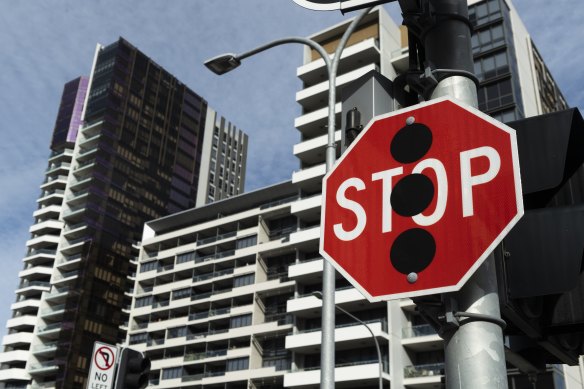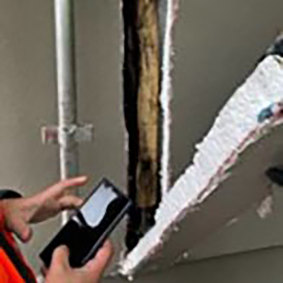Victoria is facing a crisis of leaky buildings, with construction experts blaming a lack of regulation of waterproofing, a critical skill not required to be carried out by a specialist.
Water damage tops the list of defects encountered in inspections and complaints to the Victorian Building Authority.

Hundreds of buildings inspected in Melbourne have been found to have problems with waterproofing and water ingress.Credit: Rhett Wyman
Roscon, a company that specialises in identifying building defects, has inspected hundreds of buildings throughout Melbourne in recent years – and found most have problems with waterproofing and water ingress.
“Since 2016 the big issue grabbing media and government attention has been combustible cladding … however the next big issue without a doubt will be water leaks, waterproofing and mould,” said Joshua McDonald, a senior forensic engineer at Roscon.
“Everyone from the top levels of government to the builders and trades in the industry, and especially homeowners and renters, should be extremely worried about the prevalence of this issue.”
The Age revealed on Friday that hundreds of Victorian apartments have defective balconies, most of which were related to insufficient or no waterproofing or water ingress.
The problem emerged during inspections for 339 buildings that received government funding to remove flammable cladding. They found one-in-four balconies – more than 550 – had defects.
That prompted Cladding Safety Victoria to warn that defective balconies were a widespread problem that posed serious safety risks to residents.

Timber framing on a balustrade, which has been damaged by water ingress.Credit: Cladding Safety Victoria
McDonald said that over time water caused rot, ate away timber and was generally accompanied by the growth of mould.
“Toxic mould can be severely harmful to occupants of a building, especially the young, old and immunocompromised,” he said.
Construction experts warn that faulty design, improper installation of waterproof membranes and use of inappropriate products have led to rising issues of mould, rust and corrosion.
They say there is a lack of regulation in the waterproofing industry in Victoria. Such work does not have to be carried out by a specialist in Victoria, with plans to register it as a trade yet to take effect.
Veteran building inspector Stephen Kip said Victoria needed to create competencies for the new trade of waterproofer.
“In addition requiring mandatory independent building inspections for waterproofing membranes and flashings, both inside and outside of buildings, would assist the education and compliance process,” he said.
Adam Promnitz bought a townhouse in Abbotsford that was built in the 1990s.
Promnitz, who is chair of the body corporate, said most of the balconies in the complex had to be rebuilt because there was no water membrane under the tiling.
“It’s not just the expense of repairing it,” he said. “There’s obviously the inconvenience but because of the way plan subdivisions work, it is legally very complex.”
Promnitz said an area, which included 14 private properties and as well as common space, had to be waterproofed and re-tiled. “All of a sudden it becomes a massive exercise in who pays for what.”
The Victorian Building Authority, which conducts more than 12,000 inspections a year, said water damage routinely topped the list of defects encountered in buildings and in complaints.
The authority is prioritising compliance and enforcement on water leaks and damage and running sessions for practitioners on how to mitigate the risks.
“Building practitioners are responsible for ensuring that building work complies with the National Construction Code and Victoria’s regulations, and that building activities are carried out in line with relevant building permits,” a VBA spokesperson said.
“Any practitioner found to be in breach of these rules will face enforcement action, risking financial penalties as well as the suspension or cancellation of their registration.”
Dr Nicole Johnston, an expert researcher in building defects in multi-owned properties, said leaky buildings were a huge problem that needed to be addressed.
“There’s a slowness to react to this, mainly because of the cost of dealing with these issues,” she said.
“One of the big problems is if the developer or the builder are no longer responsible or have gone into liquidation, for example, then it’s up to the owners’ corporation to deal with the defects in these buildings.”
Johnston said the cost of rectification could be enormous, especially if there were systemic water leaks throughout a building.
Australian Institute of Building Surveyors’ Victoria board director, Wayne Liddy, said there must be proper accountability right across the supply chain. Under the current system, building surveyors are expected to hold everyone else in the building process to account, he said.
“NSW is moving towards greater accountability of others in the building process through the Design and Building Practitioner’s Act 2020, which requires newly registered practitioners such as architects and designers to provide compliance declarations at various stages of the design and construction of apartment buildings,” he said.
“Introduction of similar requirements in Victoria would go a long way towards solving this very serious and ongoing problem for apartment owners.”
A Victorian government spokesperson said its building reform expert panel was conducting a comprehensive review of Victoria’s building system that would “reshape the system and deliver safe, compliant and durable buildings”.
“The panel’s stage one report includes recommendation to strengthen oversight of the building industry,” the spokesperson said.
“We will continue to work closely with the building industry and Victoria’s building regulator on the recommendations and introduction of any further reforms.”
The Morning Edition newsletter is our guide to the day’s most important and interesting stories, analysis and insights. Sign up here.
https://news.google.com/rss/articles/CBMiiQFodHRwczovL3d3dy50aGVhZ2UuY29tLmF1L25hdGlvbmFsL3ZpY3RvcmlhL3JvdC1hbmQtdG94aWMtbW91bGQtbGVha3ktaG9tZXMtY291bGQtYmUtdmljdG9yaWEtcy1uZXh0LWJ1aWxkaW5nLWNyaXNpcy0yMDIzMDcwNy1wNWRtbTEuaHRtbNIBAA?oc=5
2023-07-07 19:00:00Z
CBMiiQFodHRwczovL3d3dy50aGVhZ2UuY29tLmF1L25hdGlvbmFsL3ZpY3RvcmlhL3JvdC1hbmQtdG94aWMtbW91bGQtbGVha3ktaG9tZXMtY291bGQtYmUtdmljdG9yaWEtcy1uZXh0LWJ1aWxkaW5nLWNyaXNpcy0yMDIzMDcwNy1wNWRtbTEuaHRtbNIBAA
Bagikan Berita Ini














0 Response to "Rot and toxic mould: Leaky homes could be Victoria’s next building crisis - The Age"
Post a Comment